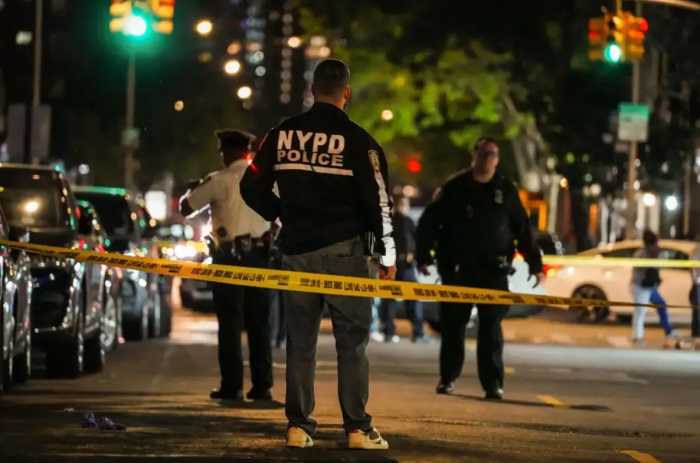By Alex Davidson
Borough educators, parents and politicians had plenty to discuss in 2003 after the mayor’s massive overhaul of schools’ organization, transfer provisions in the federal No Child Left Behind Act that worsened overcrowding in Queens and a historic $13.1-billion five-year capital plan.
Last year Queens students began attending schools in three regions, community school boards and their superintendents were superseded by the new Panel for Education Policy and 10 “super” superintendents, and parent complaints were funneled to regional offices following the contraction of individual district offices.
Teachers’ and students’ reactions to the changes, school board members said, have not been positive.
“I am seeing parents jumping now in the total opposite direction as though getting involved (in schools) was going to set their feet on fire,” said Pat Grayson, president of School Board 24, which includes the communities of Glendale, Ridgewood, Maspeth, Corona and Elmhurst. “The truth of the matter is this is not a parent-friendly organization.”
Under Mayor Michael Bloomberg’s plan announced last January, Queens was divided into three regional districts: Districts 25, 26, 28 and 29 were bundled together; Districts 24 and 30 were grouped with Brooklyn’s District 32; and District 27 was put into a group including Brooklyn’s Districts 19 and 23.
The mayor and Schools Chancellor Joel Klein introduced 10 regional superintendents throughout the city to replace the 32 district superintendents, 100 local instructional supervisors to manage 10 to 12 schools each and 10 learning support centers where parents now lodge their complaints with education department officials.
A major aim of the mayor’s and chancellor’s plan was to foster community involvement in schools, and the two placed parent coordinators in every school in the hopes of reaching more parents. This goal, according to school board members, has not been achieved.
“Everybody is left in the dark,” said Donna Caltabiano, first vice president of School Board 27, which covers the communities of Richmond Hill, Woodhaven, Ozone Park, South Ozone Park, Howard Beach and the Rockaways. “Parents do not know who to turn to; they used to come us.”
Caltabiano is also the mother of a high school student.
Sharon Maurer, president of School Board 26, which covers Bayside, Little Neck, Fresh Meadows and Bellerose, said the initial fallout from the reorganization in District 26 could cost the district its status as the top-performing district in the city.
“The year 2003 was a year of changes whose reverberations will be felt for years to come,” Maurer said.
Nine schools opened this year in the borough, including the Glen Oaks campus, which incorporates students from Districts 25, 26 and 29. Queens still had the most overcrowded schools in the city in 2003, with a shortage of 12,966 seats, according to statistics from Borough President Helen Marshall’s office.
The construction of additional Queens schools, PS 260 in Corona, K-12 schools in Forest Hills and a permanent home for the Frank Sinatra School for the Arts in Astoria, were put on a fast-track status by the city School Construction Authority. A target date has not been released for their completion.
Queens schools, overall, are running at 105 percent of capacity, the statistics showed.
Maurer cited the reorganization but mainly the federal No Child Left Behind Act, signed into law in 2001 by President George Bush, as having the most impact on District 26’s overcrowding.
Under the law, students from underperforming districts are allowed to transfer into well-performing ones. This transfer provision has complicated matters in District 26 by introducing unprepared students into a competitive education environment, Maurer said.
“There will be a major difference from last year to this year,” Maurer said of test results that chronicle borough students’ success. “And it won’t be from a lack of education.”
Maurer said the act should have called for transitional classes that would have allowed incoming students time to adapt to their new environments. She said, however, that more underprepared students will now be advancing in borough schools, creating a systemic problem for years to come in Queens.
“Instead we don’t have that (the transition classes), and it will have a devastating effect on our middle schools,” Maurer said.
U.S. Rep. Anthony Weiner (D-Kew Gardens), who voted for the bipartisan No Child Left Behind Act but has since become one of its major opponents, said the measure has shortchanged borough students by increasing academic mandates but not providing additional money to fund those mandates.
“The No Child Left Behind Act is a promise that has been broken,” Weiner said. “Regulations have choked good schools and abandoned bad ones. All the while, the funding that was delivered was $1.24 billion less than promised. The No Child Left Behind Act gets an ‘F.’”
City and state funding for borough schools was also the subject of debate in 2003 as Queens schools continued to fight increasing overcrowding in its elementary, middle and high schools. The city Department of Education’s most ambitious capital plan, a $13.1-billion initiative, was designed to introduce 22,000 seats in Queens out of the 63,000 total new seats citywide.
But half of the capital plan to begin in July is based on unconfirmed funds yet to be funneled down to the city from the state. This is because discussions are still pending about what a sound, basic education costs following the Campaign for Fiscal Equity’s lawsuit victory against the state of New York that contended city students were not receiving their fair share of education funds from Albany.
“Traditionally, we have never received the proper amount for the children of New York City,” District 24’s Grayson said. “Anyone who thinks there is going to be $13.1 billion available in this plan is crazy. I would be so happy to be wrong, though.”
Critics of the plan recall the last five-year capital plan, which similarly promised a windfall of city and state dollars but in the end was significantly reduced, leaving Queens with unbuilt schools and unfulfilled promises.
“I just cannot believe what I am seeing,” Maurer said. “They (the Education Department) have made decisions not on an educational basis but on a monetary basis.”
Overall, the changes in how borough schools are run have upset the traditional education system with which Queens educators, parents and politicians were familiar.
“Things used to be more open,” Caltabiano said. “Now there’s nothing. There’s absolutely nothing.”
Reach reporter Alex Davidson by e-mail at TimesLedger@aol.com or by phone at 718-229-0300, Ext. 156.


































